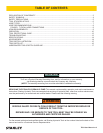
10 ► TP03 User Manual
PREOPERATION PROCEDURES
CHECK POWER SOURCE
1. Using a calibrated ow meter and pres sure gauge,
make sure the hydraulic power source develops a
ow of 7–9 gpm/26–34 Ipm at 1500–2000 psi/105–
140 bar.
2. Make certain that the power source is equipped with
a relief valve set to open at 2150–2250 psi/150–155
bar maximum.
3. Make certain that the power source re turn pressure
does not exceed 250 psi/17 bar.
4. Make sure the trash pump inlet is clear of debris.
Remove any obstruction before operating.
CONNECT HOSES
1. Wipe all hose couplers with a clean lint free cloth
before making connections.
2.
IMPORTANT
Do not connect pressure to the return port. Motor
shaft seal limit Is 250 psi/17 bar.
Connect the hoses from the hydraulic power source
to the couplers on the trash pump or trash pump
hoses. It is a good practice to connect return hose
rst and disconnect it last to minimize or avoid
trapped pressure within the trash pump motor.
NOTE:
If uncoupled hoses are left in the sun, pressure in-
crease inside the hoses might make them difcult to
connect. Whenever possible, connect the free ends
of the hoses together.
3. Observe the arrow on the couplers to ensure that the
ow is in the proper direc tion. The female coupler on
the trash pump is the inlet (pressure) coupler.
PUMP OPERATION
1. Observe all safety precautions.
2. Attach a 3-inch/76 mm diameter hose to the pump
outlet. For best performance, keep the discharge
hose as short as possible and lay it out to avoid
sharp bends or kinks.
Do not attach a nozzle to the outlet end of the dis-
charge hose. For high-pressure water pumping, use
a Stanley SM20 or SM50 and nozzle. The TP03 is
designed for high GPM water ow at low water pres-
sure (head).
3. Attach a rope or cable to the trash pump’s handle.
Lower the trash pump into the liquid to be pumped.
Do not raise or lower the trash pump by its hoses or
couplers to avoid damage to the hoses or couplers.
4.
IMPORTANT
Never point the hose at bystanders.
Turn on the hydraulic power source. Watch for sol-
ids in the liquid being pumped. If solids are exces-
sive, the discharge ow might decrease. If this hap-
pens, stop the pump and check for the cause of the
problem.
Under some conditions, the liquid being pumped
might be slowed enough so it can no longer push
particles in the liquid. If this happens, particles can
accumulate in the pumping chamber, causing fur-
ther restriction. The impeller then acts as a “grinding
wheel” which causes acceler ated trash pump wear.
Reduced liquid ow can be caused by the following:
• The trash pump sinks into solids at the bottom
of the hole.
• The end of the outlet hose is too high, causing
an excessive lift height for the column of liquid
being pushed by the trash pump. This slows the
ow of liquid to a level where it can no longer
carry solids.
• The ow and pressure of hydraulic uid to the
trash pump is too low, which re duces impeller
speed. A 20 percent de crease in hydraulic uid
ow can reduce pump performance by 50 per-
cent. When operating at reduced hydraulic ow
and pressure, the end of the outlet hose should
not be more than 30 ft/9 m above the liquid.
NOTE:
It will not damage the pump to operate it “dry.”
OPERATION


















